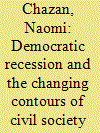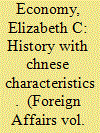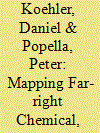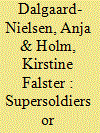|
|
|
Sort Order |
|
|
|
Items / Page
|
|
|
|
|
|
|
| Srl | Item |
| 1 |
ID:
126436


|
|
|
|
|
| Publication |
2012.
|
| Summary/Abstract |
Civil society in Israel has emerged not only as the key victim of the democratic recession currently engulfing the country, but also as the main source of its democratic promise. There is a direct correlation between the intensified efforts of neo-nationalist groups to curtail civil society and its increased centrality as the locus of the ongoing struggle for the assurance of a just, egalitarian and pluralistic Israel.
This essay briefly surveys the emergence of civil society in Israel and its characteristics; it then analyzes recent attacks on civil society organizations and consequent shifts in its structure and activities. On this basis it discusses some of the implications of Israel's present democratic crisis and seeks to reassess the outlook for democratic durability in the country. The main contention of this analysis is that there is a close connection between the vibrancy of Israeli civil society and its democratic resilience. Today, Israel's reactivated civic sector stands as the last bastion between an ultra-nationalist takeover and democratic survival.
|
|
|
|
|
|
|
|
|
|
|
|
|
|
|
|
| 2 |
ID:
193037


|
|
|
|
|
| Summary/Abstract |
Against the background of seemingly uncontrollable social menace and environmental nuisance of street children, this study examined the effects of open space characteristics on the spatial distribution of street children in Ibadan, Nigeria. With open space types in the city as spatial units of data collection, enumeration of street children was carried out in each space type within 7 weekdays in the morning, afternoon and evening. Observation was also conducted to know the socio-economic and physical characteristics of the urban environment attracting the children. The study, which employed z-scores to compare the intensity of street children incidence across the spatial units, confirmed that the incidence was a function of the uses to which open space types were put as well as the disorderliness of urban physical environment (indiscriminate parking, formal and informal economic activities, and so on). The most important open space types that attracted street children were markets, mosque premises and junctions. Although, incidence of street children was a daily affair in Ibadan, it was highly pronounced in the evening on Saturday, Friday and Monday. The study recommended development of policy measures for regulating the use of open spaces, and giving adequate planning attention to roundabouts, religious centres (mosques in particular) and markets in urban centres. It also recommended public education and enlightenment programme on the negative effects of street children incidence by all stakeholders, and that the aspect of culture of the people that encourages child begging and alms giving should be discouraged in its entirety.
|
|
|
|
|
|
|
|
|
|
|
|
|
|
|
|
| 3 |
ID:
153378


|
|
|
| 4 |
ID:
175741


|
|
|
|
|
| Summary/Abstract |
The threat of chemical, biological, radiological and nuclear (CBRN) terrorism is widely attributed to collective actors based on a religious ideology, e.g. globally operating Salafi-jihadist groups like al-Qaeda or ISIL. Only limited attention has been given to the CBRN threat of violent domestic extremists in general or far-right terrorists specifically. Nevertheless, a number of incidents involving far-right activists and CBRN agents in Western countries are known to the public, even though these have had comparatively little impact on public threat perception. This study systematically collected public information about far-right CBRN incidents to identify their main characteristics. The authors were able to identify 31 incidents in Western countries since 1970, which display features contrary to generally assumed forms of CBRN terrorism. Far-right CBRN terrorism appears to be predominantly a lone-actor phenomenon oftentimes involving middle-aged and comparatively well-educated male perpetrators, mostly motivated by non-religious forms of far-right ideology (i.e. neo-Nazism, non-religious white supremacism) and indiscriminately targeting victims. Overall, far-right actors attempting to weaponize CBRN agents have been few and generally technically inept. However, the characteristics of the plots pose potential challenges for effective counter-measures and intervention, should the number of actors or the technical sophistication of plots increase in the future.
|
|
|
|
|
|
|
|
|
|
|
|
|
|
|
|
| 5 |
ID:
169095


|
|
|
|
|
| Summary/Abstract |
Special Operations Forces (SOFs) are increasingly central in national defense postures worldwide. The term “SOF mind-set” encapsulates the current political enthusiasm but is rarely explicitly defined or systematically studied. Based on a literature review, this article suggests a conceptual model of SOF’s mind-set, which is refined via a Danish case study. It discusses when and where this mind-set complicates collaboration with the wider military organizational environment and how SOF could navigate potential fault lines. By systematically unpacking SOF’s mind-set, the article aims to add nuance to polarized conceptions and stereotypes.
|
|
|
|
|
|
|
|
|
|
|
|
|
|
|
|
| 6 |
ID:
107672


|
|
|
|
|
| Publication |
2011.
|
| Summary/Abstract |
This paper outlines the present situation of Tibetology in contemporary China and shows the achievements and latest developments of Tibetology in contemporary China. It highlights the characteristics of Tibetology in contemporary China, based on analyzing the main fields of Tibetology. Furthermore, this paper assesses the dynamics and excellent features of Tibetology in China.
|
|
|
|
|
|
|
|
|
|
|
|
|
|
|
|
|
|
|
|
|